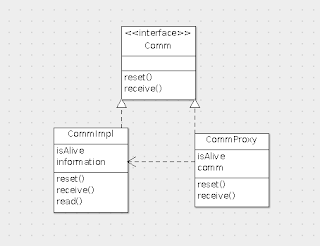Index
Theory
The proxy pattern Provide a surrogate or placeholder for another object to control access to it.
One reason for controlling access to an object is to defer the full cost of its creation and initialization until we actually need to use it.
In this example we have simulated a remote communication as you will see.
The UML model is
Figure-1
Code of the application
Comm Interface
package com.patterns.proxy;
public interface Comm {
public String receive();
public boolean reset();
}
CommImpl Class
package com.patterns.proxy;
public class CommImpl implements Comm {
private static int INFOLENGTH = 10;
private boolean isAlive = false;
private String information;
public String receive() {
// TODO Auto-generated method stub
if(isAlive) mockCall();
return read();
}
public boolean reset() {
if(isAlive) isAlive=false;
else isAlive = true;
return isAlive;
}
public String read() {
// TODO Auto-generated method stub
if(isAlive)
information = this.generateInfo();
return information;
}
void mockCall() {
try {
Thread.sleep(500);
} catch (InterruptedException e) {
// TODO Auto-generated catch block
e.printStackTrace();
}
}
String generateInfo() {
StringBuffer sb = new StringBuffer();
String base = "ABCDEFGHIJKLMNOPQRSTUVWXYZ";
for(int i=0;i
CommProxy Class
package com.patterns.proxy;
public class CommProxy implements Comm{
private static CommImpl comm;
private boolean isAlive;
public CommProxy() {
comm = new CommImpl();
}
public String receive() {
if(isAlive) /*new information arrived */
return comm.receive();
else
return "NO NEW INFORMATION=" + comm.receive();
}
public boolean reset() {
isAlive = comm.reset();
return isAlive;
// TODO Auto-generated method stub
}
}
App Class
ckage com.patterns.proxy;
/**
*
*/
public class App
{
public static void main( String[] args )
{
String message;
CommProxy proxy = new CommProxy();
proxy.reset();
message = proxy.receive();
System.out.println("Mess-1"+ message);
proxy.reset();
message = proxy.receive();
System.out.println("Mess-2"+ message);
proxy.reset();
message = proxy.receive();
System.out.println("Mess-3"+ message);
}
}
![[ Puerto Cero Uno ]](https://blogger.googleusercontent.com/img/b/R29vZ2xl/AVvXsEhiXs7hWiiK0_ETMqSqjEYdPtKVGAtAw_S16cM3u-3t1kwYIw-FM1aSQeOkrlr9lmqom-9Kw9kz0ZoPNXfpYGC_CIbLwn20L7Ps3leRsUpjPp63xioaYTeMLJsI-2JnRc8mWwH76Jbhn-jx/s752/puertocerounobanner.jpg)

No hay comentarios :
Publicar un comentario